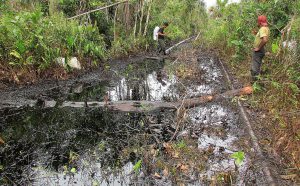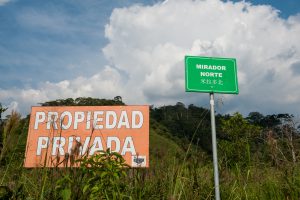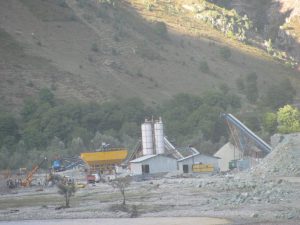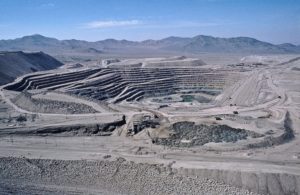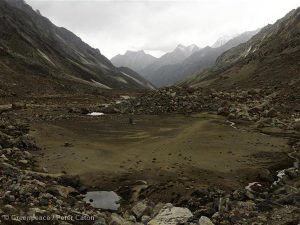China’s voracious appetite for minerals has been a key driver of Latin American growth, transforming it in less than two decades into a major player in the region.
However, Chinese-run mines – combined with Chinese loans and ever-greater involvement of Chinese companies in other sectors such as infrastructure – are sparking fears about the social and environmental impacts, and whether unequal economic development might cause future problems.
“Fifteen years ago China didn’t appear in Latin American countries’ statistics regarding trade and investment, but over the last five years it has become the first, second or third trading partner of practically all countries in the region,” says Enrique Dussel Peters, from Mexico’s National Autonomous University.
Nowhere has China’s impact in Latin America been as great as in Peru, whose long history of mining and Chinese immigration makes it particularly attractive.
Minmetals’ acquisition of Las Bambas – a US$7 billion deal confirmed in July – means Chinese interests now control one third of Peru’s mining sector, according to the president of Peru’s Chamber of Commerce. When Las Bambas starts production next year, it is expected to generate some 400,000 tonnes of copper per annum – half destined for China.
Similarly, the acquisition of assets from Petrobras by PetroChina, a listed company controlled by Chinese state firm CNPC, means CNPC will be involved in four out of Peru’s five biggest-producing oil concessions.
“Las Bambas is now owned by a company from China, and if they take a [financial] interest in Tintaya the southern Andes could go Chinese,” says Ximena Warnaars, from Earthrights International in Peru.
Trade between China and Peru has blossomed too; they signed a trade agreement in 2009 – China’s second in Latin America, after Chile.
Between 2003 and 2008 Peru’s per capita GDP growth averaged more than 8%, and just under 6% between 2009 and 2012. According to the World Bank, the export of goods and services accounted for more than a quarter of Peru’s GDP during those years, and China, argues researcher Alan Fairlie at Peru’s Pacific University, has been Peru’s biggest trade partner since 2011.
“Peru, along with Chile, has been selling commodities to China hand-over-fist,” says Carol Wise, from the University of Southern California. “Iron ore, copper, fish-meal. . . It has been huge for them. Peru has benefited absolutely the most.”
According to Wise, Chinese-Latin American trade is concentrated in five countries: Peru, Chile, Argentina, Colombia and Brazil. In 2009 China overtook the USA to become Brazil’s biggest partner – with soy, oil and iron ore the top three exports.
However, China’s growing prominence in the region’s trade raises serious concerns. Worries include unequal exchanges – with Mexico in particular – and possible future poverty traps, unless governments balance the minerals boom by developing other industries.
China’s current economic strength was achieved by attracting foreign investment into the manufacturing sector, whilst braving rejection by insisting on technology transfer from would-be investors.
“Latin America sends raw materials to China and in return buys manufactured goods,” says Dussel Peters. “This isn’t sustainable in the medium- or long-term, and the people who know this best are the Chinese. They’d never accept this kind of trading relationship themselves."
Another simmering issue is that trade ties are unevenly spread across the region. Exports from Mexico, Ecuador, Paraguay and “most central American and Caribbean countries” to China remain comparatively tiny, states Yong Zhang, from the Chinese Academy of Social Sciences, in a recent academic paper.
Infrastructure construction is another sector seeing a rise in ambitious, large-scale projects and plans by Chinese interests in Latin America.
One emblematic example is the Hong Kong-based HKND Group’s plans to build a canal cutting through Nicaragua, running from its western Pacific Ocean coast to its eastern Caribbean Sea coast, in order to cater for a projected rise in global maritime trade. A route for the 172-mile canal was approved last month: it is set to pass through Central America’s biggest lake, Lake Nicaragua, and to be three times the length of the Panama Canal.
Another potent example is Chinese companies’ interest in building a railway all the way across South America from Peru’s Pacific Coast to Brazil’s Atlantic Coast. Brazil’s president Dilma Rousseff pledged to “work together with China and Peru to build this project into a satisfactory one,” according to Xinhua in July.
Infrastructure finance
Chinese companies are also directly involved in, or linked to, other kinds of infrastructure projects.
Following the “G77+China” summit in June the president of Bolivia’s Santa Cruz region’s Chamber of Commerce was reported by AFP saying that China is interested in “industrialization projects” in Bolivia costing an estimated US$42 billion. Last year a consortium led by China Gezhouba Group Corporation (CGGC) won a contract to build two hydroelectric dams in Argentina.
Chinese companies are now associated with 24 dam projects across Latin America, according to Beijing-based Grace Mang, the China Program Director at NGO International Rivers.
China has also found itself playing an increasingly important – and in some cases vital – role providing loans to the region, especially since the global financial crisis. Chinese banks lent more than US$100 billion to Latin American and Caribbean governments and companies between 2005 and 2013, according to Boston University researchers Amos Irwin and Kevin Gallagher, with more than half going to Venezuela. Argentina, Brazil and Ecuador held second, third and fourth places.
“One of the major things about China’s funding is that it acts as an alternative source, not just to the World Bank or the Inter-American Development Bank, but Western commercial banks too,” says Irwin. “This is especially clear in Ecuador where they showed investors they could get by with Chinese lending even after they defaulted on their sovereign debt, causing their credit rating to plummet and scaring off all other foreign lenders."
Chinese state-owned banks are also loaning billions directly to Chinese state-owned companies operating abroad. Irwin and Gallagher estimate that such loans could total US$140 billion since 2002, roughly 80% of them channeled to the oil and mining sectors.
“This is much more recent than the trade ties and is a second wave in the new economic relationship between Latin America and China,” says Dussel Peters. “Since the economic crisis, China has been exporting capital in such a manner that in the last two or three years it has become the third major source of overseas foreign direct investment.”
Chinese banks are now set to take their financing role to yet another level. Last month the BRICS summit agreed to establish a US$100 billion “New Development Bank” headquartered in Shanghai to finance “infrastructure and sustainable development projects” in BRICS and other “developing” countries, as well as a reserve pool of a US$100 billion, called a “Contingent Reserve Arrangement”, to tide countries over in case of balance of payments problems.
However, there is considerable concern among certain sectors about the potential impacts of China’s growing presence – on Latin American society, the environment, even national sovereignty. Partly this is because any investment or project is viewed as cause for concern, and partly because of China’s domestic environmental record, labour conditions , and lack of transparency and accountability.
Some Chinese companies have already bought into particularly controversial projects. In Peru these include the two most contentious – and two of the biggest-producing – oil concessions where serious contamination has led to “environmental emergencies” being declared in four different river basins, and mines like Marcona, Rio Blanco and Toromocho.
Rio Blanco was bought by a consortium led by Zijin Mining despite several years of unrest under the previous owner that saw protests by thousands of people, torture, killings and a UK High Court case.
At Toromocho, run by state-owned Chinalco, tension flared over attempts to relocate an entire town, Morococha, of almost 5,000 people. While some are positive about how Chinalco has handled the move, others are much less so. According to Daniel Alvarez Tolentino, from the Office of the Archbishop of Huancayo, the new site chosen for the town is totally inappropriate, the new houses are too small and are affecting children’s health, and about 120 families have refused to move and now find themselves largely abandoned.
In March the government ordered Chinalco to stop operating following concerns about environmental impacts, and on 6 August two lawsuits were filed against the company and the Ministry of Energy and Mines by Morococha grassroots organization FADDIM.
“There’s a complete rejection of Chinalco by the people who continue living at Old Morococha,” says Alvarez Tolentino.
Meanwhile, across the border in Ecuador two Chinese state-run companies now control the country’s most notorious mining project, Mirador, and CNPC is slated to exploit new oil concessions in the world-famous Yasuni National Park deep in the Amazon rainforest – operations that have met with national and international condemnation and a lawsuit filed by indigenous organization ECUARUNARI.
In addition, in Ecuador’s recent, controversial auction of what was initially intended to be 21 new oil concessions bids were received on only three – two by Chinese company Andes Petroleum. Both these concessions, called “Block 79” and “Block 83”, overlap territory belonging to the indigenous Sapara (or Zápara) people in the Amazon. Earlier this year Sapara leaders Klever Ruiz and Gloria Ushigua lobbied the United Nations rejecting oil operations in their land.
“The existence of our people is in grave danger,” they wrote. “We have resolved in multiple assemblies, congresses, and indigenous declarations that we don’t want extractive industry like oil exploitation in our territory.”
International Rivers’ Mang acknowledges that Chinese firms “have been getting into projects otherwise spurned by others” and cites the Patuca dams in Honduras as examples. According to Andy White, from the NGO Rights and Resources Initiative based in Washington, Chinese companies have lower standards for social and environmental governance.
“Citizens have very little access to, and far fewer means to influence, corporate decision makers,” he adds.
However, others argue that the regulations binding Chinese banks when making loans set higher standards than their Western contemporaries. Although there is mixed evidence it is being complied with since it was adopted two years ago, China’s “Green Credit Directive” (GCD) – a government regulation requiring banks to consider socio-environmental impacts before making loans – is thought by some to exceed Western green finance models.
“The GCD sets a very high bar,” says Paulina Garzon, from Ecuador’s Centre for Economic and Social Rights (CDES), although she points out that putting it into practice is another matter.
“Two things that Chinese banks and many countries in Latin America have in common are that their environmental regulations are OK, but the implementation and supervision systems are very weak,” she says. “Chinese investments in Ecuador are massive, and so far they promise to be environmentally tragic for the country."
The impact of Chinese operations in Ecuador has arguably generated more concern than anywhere else. In addition to mining and exploiting oil in the Amazon, Chinese companies are now involved in a series of hydroelectric dam projects, and proposals to build an oil refinery on the Pacific Coast. Chinese banks have lent so much money that some argue the national debt is out of control and Ecuador’s sovereignty is under threat.
Ecuadorian civil society is fighting back, adopting strategies such as lobbying Chinese banks, taking legal action, publishing a manual on socio-environmental regulations for Chinese loans and investment abroad, and appealing to international institutions like the Inter-American Commission on Human Rights.
“The problem with Chinese firms is they don’t care much about human rights, although they are more open to talking about the environment,” says Warnaars, from EarthRights International. “That’s what communities against Mirador in Ecuador understood in a complaint they made to the [Inter-American] Commission.”
But others are much more positive, or play down differences between Chinese and non-Chinese companies. “In terms of long or short-term impact in Peru we only have one case to look at – Shougang [the company running the Marcona mine] – and that case is known for being really terrible,” says Irwin. “There are definitely enormous labour problems, but in terms of the environmental and social working conditions they are very similar to other companies in Peru."
According to Margaret Myers, from the Inter-American Dialogue think tank in Washington, Chinese companies have been through a “real learning process” – Shougang was a “disaster” but Chinalco has done a “very good job” with Toromocho.
“When regulations and standards are upheld Chinese firms tend to abide by them,” she says. “When they’re not, then there’s leeway for firms to do whatever is in their best interests. This isn’t exclusive of Chinese firms. You see that in plenty of multinationals."
